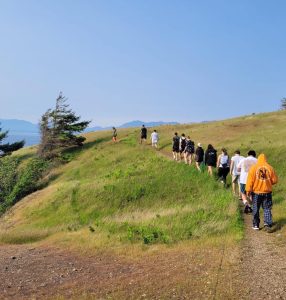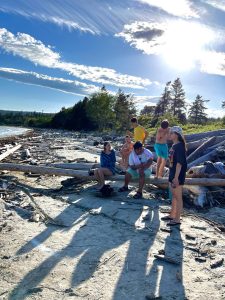I. General Information
School Name: Learning Alternatives
School District: SD#68 Nanaimo-Ladysmith
Inquiry Team Members: Lacey Daly: lacey.daly@hotmail.com, Trevor McIntyre: trevor.Mcintyre@sd68.bc.ca, Brett Hancock: bhancock@sd68.bc.ca
Inquiry Team Contact Email: lacey.daly@sd68.bc.ca
II. Inquiry Project Information
Type of Inquiry: NOIIE Case Study
Grade Levels Addressed Through Inquiry: Secondary (8-12)
Curricular Areas Addressed: Career Education, Physical & Health Education, Other: SEL
Focus Addressed: Community-based learning, Experiential learning, Growth mindset, Self-regulation, Social and emotional learning, Transitions
In one sentence, what was your focus for the year? Mitigating the negative effect of trauma on a student’s success rate while supporting them to process the event(s) and learn better ways to cope.
III. Spirals of Inquiry Details
Scanning: This year we want to continue focusing on Adverse Childhood Experiences (ACEs), as we know from our work last year the scores in our school are very high. Specifically, we hope to lean into strategies we can implement at school to lessen the negative effects of trauma while supporting student coping methods. In our scanning phase, it is abundantly clear that the need to support our students in this regard has never been greater. Students are displaying much higher rates of anxiety, depression, and substance abuse. The effects of financial hardships within the community are an additional layer that we also need to contend with.
Focus: Mitigating the negative effect of trauma on a student’s success rate, while supporting them to process the event(s) and learn better ways to cope, is a critical focus area for supporting alternative education students. Many alternative education students come from diverse backgrounds and may have experienced significant trauma in their lives, which can significantly impact their academic performance and overall well-being. By addressing and acknowledging the impact of trauma, we create a safe and supportive environment that fosters healing, resilience, and growth. By providing targeted support and interventions to help students process their experiences, develop healthy coping mechanisms, and build emotional regulation skills, we empower them to navigate challenges and maximize their academic potential. This focus area recognizes the importance of addressing the whole student, promoting their overall success, and ensuring equitable opportunities for alternative education students to thrive academically and personally.
Hunch: At our school, we recognize the significance of understanding and addressing the factors that may have contributed to the experiences of our learners. Our students often face unique challenges, and it is crucial to reflect on the practices within our school system (prior to arriving at Learning Alternatives) that may have influenced their experiences. In some cases, traditional disciplinary approaches, rigid academic structures, and a lack of individualized support may have inadvertently contributed to the difficulties faced by our learners. By critically evaluating our practices and policies, we can create a more inclusive and trauma-informed learning environment. This includes adopting restorative practices that prioritize building relationships, fostering a sense of belonging, and providing targeted interventions that address the specific needs of our students. It is essential to foster a culture of empathy, understanding, and support that allows our learners to heal, thrive, and reach their full potential. By doing so, we can create a nurturing and empowering educational experience for our alternative education students.
New Professional Learning: In our commitment to mitigating the negative effect of trauma on student success and supporting their healing and coping processes, we embarked on a journey of professional learning to explore new areas of expertise. We delved into trauma-informed practices, social-emotional learning, and restorative approaches, seeking to deepen our understanding and expand our toolkit of strategies. We engaged in literature and workshops that focused on trauma-informed pedagogy, understanding the impact of adverse experiences and fostering resilience in students. The resources that proved most helpful were the books, The Myth of Normal: Trauma, Illness, and Healing in a Toxic Culture by Daniel Maté and Gabor Maté, and Fostering Resilient Learners by Kristin Souers. These resources provided valuable insights and practical techniques for creating trauma-informed classrooms. To support the learning of my colleagues, I organized professional development sessions where we explored trauma-informed practices together. We engaged in reflective discussions, case studies, and collaborative planning to design inclusive learning environments and develop strategies to support students affected by trauma. Through these efforts, we aimed to foster a culture of empathy, understanding, and resilience within our school community, ultimately enhancing student success and well-being.
Taking Action: As a team committed to mitigating the negative effect of trauma on student success, we developed and implemented several strategies to create a supportive and inclusive learning environment. Firstly, we established a trauma-informed classroom approach by incorporating predictable routines, visual schedules, and designated safe spaces where students could self-regulate and seek support. We also focused on building positive relationships with students through regular check-ins, active listening, and validating their experiences.
To enhance our collective understanding of trauma and its impact, we organized professional learning communities (PLCs) focused on trauma-informed practices. We engaged in reflective discussions, shared resources and articles, and invited guest speakers to deepen our knowledge. These PLCs provided a platform for open dialogue, collaboration, and ongoing professional growth.
We also collaborated closely with the school’s counselling department and community organizations to provide additional support to students affected by trauma. This included referrals to counsellors, mental health resources, and trauma-informed interventions. By leveraging external expertise, we ensured a comprehensive and holistic approach to supporting our students’ well-being.
Photo description: We take every opportunity possible to connect with our students on a deeper level and give them opportunities for growth outside the walls of our school. This is a small snapshot of the joy and growth that some of our activities presented. Watch a short video clip here.
Checking: The impact of these strategies was noticeable in the classroom. Students exhibited increased self-awareness, improved self-regulation skills, and greater engagement in their learning. We witnessed enhanced student-teacher relationships, a more inclusive classroom climate, and a decrease in behavioral incidents. Academic progress and overall student well-being also showed positive growth.
Throughout the process, we regularly assessed and reflected on the effectiveness of our strategies, seeking feedback from students, parents, and colleagues. This continuous improvement approach allowed us to fine-tune our practices and tailor interventions to meet the unique needs of our students.
Reflections/Advice: Through this inquiry, we have learned the transformative power of trauma-informed practices in supporting students’ success and well-being. We confirmed the importance of creating safe and inclusive learning environments, building positive relationships, and integrating restorative approaches. The impact of our efforts has reinforced the significance of addressing trauma’s effects on students’ lives and academic journeys.
Looking ahead, we plan to continue our professional learning and deepen our understanding of trauma-informed practices. We aim to explore additional resources, attend relevant conferences, and engage in ongoing collaboration with colleagues to refine and expand our strategies. We will also seek feedback from students, parents, and our school community to further refine our approach and ensure it meets the evolving needs of our students.
For other schools with a similar interest, we offer the following advice:
- Commit to continuous learning: Invest in professional development opportunities that focus on trauma-informed practices, social-emotional learning, and restorative approaches. Encourage a growth mindset among staff members and create a culture of ongoing learning and reflection.
- Foster collaboration: Build strong partnerships between teachers, support staff, and administrators. Engage in regular team meetings, PLCs, and collaborative planning sessions to share insights, resources, and best practices.
- Create a safe and inclusive environment: Establish clear expectations, routines, and safe spaces within the classroom to promote emotional well-being and provide students with a sense of stability and security.
- Build positive relationships: Prioritize building strong relationships with students based on trust, empathy, and respect. Take the time to understand and validate their experiences, and provide opportunities for open dialogue and active listening.
- Integrate restorative practices: Incorporate restorative circles, conferences, or other restorative approaches to address conflicts and promote accountability and healing within the classroom community.
- Collaborate with support services: Work closely with school counsellors, social workers, and community organizations to access additional resources, interventions, and support for students affected by trauma.
- Monitor progress and adapt: Regularly assess the impact of your strategies and interventions through student feedback, data analysis, and observation. Adjust your practices as needed to meet the evolving needs of your students.
By implementing these recommendations, schools can create environments that support the healing and growth of students affected by trauma, leading to improved academic success and overall well-being. Remember, it is a collective effort that requires ongoing commitment, collaboration, and a deep understanding of a student’s individual needs and experiences.

